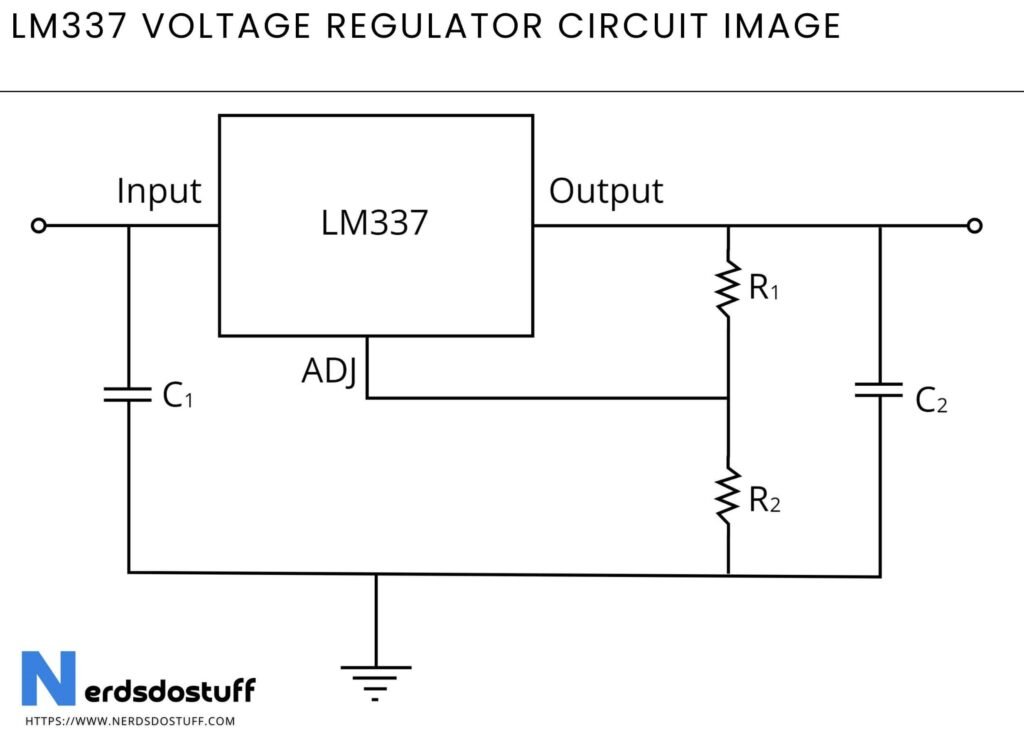What is LM337 Voltage Regulator ?
The LM337 is a three-terminal adjustable negative voltage regulator integrated circuit (IC) that operates similarly to its positive counterpart, the LM317. It is designed to provide a stable and adjustable negative output voltage when connected in a suitable circuit configuration.
Like the LM317, the LM337 contains an internal voltage reference, a pass transistor, and a feedback mechanism. However, in the LM337, the output voltage is negative relative to its input voltage. By connecting external resistors or a potentiometer between the ADJ pin and ground, users can adjust the output voltage within a specified range. The LM337 is capable of providing output voltages ranging from -1.25 volts to approximately -37 volts, depending on the specific model and configuration.
LM337 Voltage Regulator Circuit

Features of LM337 Voltage Regulator
| Feature | Description |
|---|---|
| Input Voltage Range | -40 V to -3 V (Typical) |
| Output Voltage Range | Adjustable from -1.25 V to -37 V (Typical) |
| Output Current | Up to 1.5 A continuous (Depending on heatsink and ambient temperature) |
| Dropout Voltage | Typically 1.25 V at 1 A output current |
| Line Regulation | 0.01% per volt variation in input voltage |
| Load Regulation | 0.1% per amp variation in load current |
| Ripple Rejection | 80 dB (Typical) |
| Temperature Range | -40°C to +125°C (Operating) |
| Thermal Shutdown | Yes |
| Short-Circuit Protection | Yes |
| Adjustable Output Voltage | Yes (By connecting external resistors or potentiometer to the adjustment pin) |
| Package Types | TO-220, TO-220FP, TO-263 (D2PAK), TO-252 (DPAK), and other surface-mount packages |
Working of LM337 Voltage Regulator
The LM337 voltage regulator functions in a manner similar to its positive counterpart, the LM317, but it provides a stable and adjustable negative output voltage. Here’s how it works:
- Internal Reference Voltage: Like the LM317, the LM337 contains an internal reference voltage of approximately 1.25 volts between its adjustment (ADJ) pin and its output pin. This reference voltage serves as a comparison point for regulating the output voltage.
- Feedback Loop: The output voltage of the LM337 is determined by the ratio of two external resistors connected between the ADJ pin and the output pin, just as in the LM317. Adjusting the values of these resistors allows users to set the desired negative output voltage within a specific range.
- Voltage Regulation: When an input voltage is applied to the LM337, it regulates the negative output voltage by adjusting the pass transistor’s conductivity. If the output voltage falls below the desired level, the LM337 increases the pass transistor’s conductivity, allowing more current to flow from the input to the output and thus raising the negative output voltage. Conversely, if the output voltage exceeds the desired level, the LM337 decreases the pass transistor’s conductivity, limiting the current flow and lowering the negative output voltage.
- Stability and Protection: Similar to the LM317, the LM337 incorporates various features such as thermal overload protection, current limiting, and short-circuit protection to ensure safe and reliable operation. These protections safeguard against excessive heat, overcurrent conditions, and short-circuit events, enhancing the regulator’s reliability in various applications.
Applications of LM337 Voltage Regulator
- Power Supplies
- Battery Chargers
- Adjustable Voltage Regulators
- LED Drivers
- Voltage References
- Voltage Regulation in Automotive Electronics




